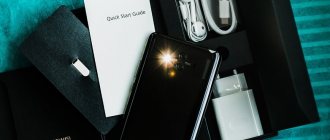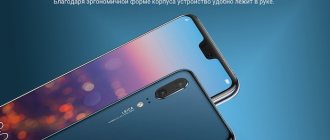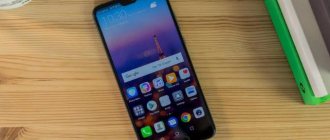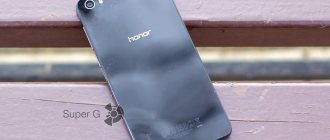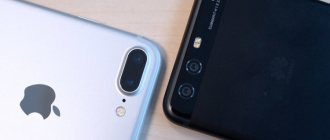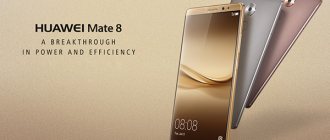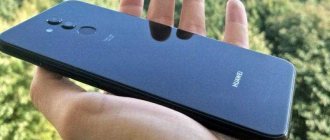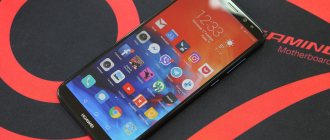Review of the Huawei Mate 10 Pro smartphone and its characteristics
Nowadays, a powerful processor, frameless design and a huge amount of built-in memory will no longer surprise anyone; not only every flagship, but even mid-price devices can boast of this.
A modern smartphone has a performance reserve for at least several years ahead and can easily cope with any tasks, but where to go next? After all, we need to somehow develop the industry, and every year it becomes more and more difficult to offer something new. The hero of our review is Huawei Mate 10 Pro, in which the manufacturer offered something truly new that we have never seen anywhere else - a smartphone that will only get better every year, self-learning and adapting to the user’s needs.
Let's review the Mate 10 Pro and see what such an unusual solution is really capable of.
⇡#Communications and wireless communications
Huawei Mate 10 Pro and ASUS Zenfone 4 Pro are two smartphones with officially the fastest LTE modems on board. Both, however, have not yet gone on sale - let's see who ultimately wins this race. But LTE Cat.18 with a maximum download speed of 1.2 Gbit/s will no longer be taken away from them. Another thing is that there is practically no place to achieve such speed yet, but at least the Mate 10 Pro has a foundation for the future. The upload speed, by the way, is the usual 150 Mbit/s.
Slot for two nano-SIM cards
The Mate 10 Pro has two slots for nano-SIM cards, operating in dual stand-by mode (when one SIM card is active, the second one temporarily becomes unavailable).
All wireless modules are in place, without exception: Bluetooth 4.2 LE (why not faster 5.0? It’s not clear.), Wi-Fi 802.11a/b/g/n/ac (2.4/5 GHz) with Wi support -Fi Direct, NFC (with Android Pay support) and even an infrared port for controlling household appliances.
| Huawei Mate 10 Pro, AndroiTS GPS Test results | ||
The navigation module works with GPS (including A-GPS), GLONASS, Galileo, BeiDou. There are no problems here - communication with satellites is established instantly. After 15 seconds, the smartphone determines your location with an accuracy of 4-6 meters.
Technical characteristics of Huawei Mate 10 Pro:
- Screen: OLED, 6″, 2160×1080 (402 ppi), HDR10
- Processor: eight-core HiSilicon Kirin 970, (4 x 2.36 GHz + 4 x 1.8 GHz), integrated neuroprocessor module
- Graphics accelerator: Mali-G72 MP12
- Operating system: Android 8.0 Oreo with EMUI 8.0 firmware
- RAM: 6 GB
- Built-in memory: 128 GB
- Memory card support: no
- Communication: GSM 850/900/1800/1900 MHz || UMTS 800/850/900/1700/1900/2100 MHz || LTE: 1, 2, 3, 4, 5, 6, 7, 8, 9, 12, 17, 18, 19, 20, 26, 28, 32, 34, 38, 39, 40
- SIM: 2x nano-SIM, Dual SIM Dual Standby (DSDS)
- Wireless interfaces: WiFi 802.11 b/g/n/ac, Bluetooth 4.2, infrared sensor, NFC
- Navigation: GPS, GLONASS, BeiDou
- Main camera: main - 20 MP (monochrome) + 12 MP (RGB), f/1.6, optical stabilization, flash, phase detection and laser autofocus, continuous autofocus during video shooting (CAF)
- Front camera: 8 MP, f/2.0
- Sensors: light, motion, microgyroscope, accelerometer, magnetometer, barometer, fingerprint sensor
- Water and dust protection: IP67
- Battery: 4000 mAh, non-removable, Huawei SuperCharge fast charging
- Dimensions: 154.2x74.5x7.2 mm
- Weight: 178 grams
Detailed technical specifications
Make and model
Make and model of the device, and alternative names (if any).
| Brand Device manufacturer company. | Huawei |
| Model Device name. | Mate 10 Pro |
| Alternative names Other model names, if available. Sometimes the model is called differently, depending on the country or because of popular nicknames. | BLA-L09 BLA-L29 |
Design
Appearance of the device including dimensions, weight, volume, colors and materials.
| Width The horizontal side of the device when used in standard orientation. | 74.5 mm (millimeters) |
| Height The vertical side of the device when used in standard orientation. | 154.2 mm (millimeters) |
| Thickness The cross-sectional size of the device. | 7.9 mm (millimeters) |
| Weight How much does the device weigh excluding the case, SIM and memory cards and other additional elements. | 178 g (grams) |
| Volume Approximate value calculated using the formula: length times width times height. | 90.75 cm³ (cubic centimeters) |
| Colors What colors is the device available in? | Gray Blue Brown |
| Housing materials What materials is the body made of? | Aluminium alloy |
System on a Chip (SoC)
A system on a chip, a single-chip system (System on a Chip, SoC) is when several systems performing different device functions are connected on one chip.
| System on a Chip (SoC) A single-chip system that contains components such as a processor, graphics accelerator, memory units, communication interfaces, etc., as well as software for the operation of the system. | Huawei HiSilicon KIRIN 970 |
Central processing unit (CPU)
| Central processing unit (CPU) The main component of the device is responsible for calculations and data processing. | 4x 2.36 GHz ARM Cortex-A73, 4x 1.84 GHz ARM Cortex-A53 |
| Technical process What technological process is used to make the chip? The smaller the process technology, the better - the chips consume less power and generate less heat. | 10 nm (nanometers) |
| Processor size Processor capacity is a parameter that indicates how many bits of data a processor register processes in 1 clock cycle. This is usually 32 or 64 bits. | 64 bit |
| Instruction Set Architecture Instruction set architecture (ISA) is a programmable part of the microprocessor core used by software to control the operation of the processor. | ARMv8-A |
| Number of processor cores The processor can be either single-core or multi-core. The performance of the processor depends on the number of cores (threads). The more cores working simultaneously, the higher the power consumption, so in mobile devices all cores are used only under high load. | 8 |
| CPU clock speed Clock speed is the number of operations per second that a processor or its core can achieve. The higher the frequency, the higher the overall performance of the device, but performance also depends on the processor architecture and the number of cores. | 2360 MHz (megahertz) |
Graphics Processing Unit (GPU)
| Graphics Processing Unit (GPU) The graphics processing unit (GPU) is used to process and display graphics - 3D effects, games, interfaces and other visual elements. Due to the pipeline architecture, the GPU is many times more efficient in graphics processing than the processor. | ARM Mali-G72 MP12 |
| Number of GPU cores Similar to a processor, a GPU can have one core or several. The number of cores (threads) determines the performance and amount of information processed. The more cores, the better. | 12 |
Random access memory (RAM)
| Amount of random access memory (RAM) RAM (Random Access Memory, RAM, RAM) is temporary memory (works only while the device is running), which stores data and code for the operational operation of programs and applications. The more RAM, the more programs you can run simultaneously without loss of performance (there will be fewer “brakes”). | 4 GB (gigabytes) 6 GB (gigabytes) |
| Type of random access memory (RAM) Information about the type of RAM used by the device. | LPDDR4X |
| Number of RAM channels 1 is a single-channel RAM operating mode, basic, when 1 memory module is used. 2 is already a two-channel mode - a mode of parallel operation of 2 modules or pairs of modules, memory channels - this mode is 2 times faster than a single-channel one. 3 – three-channel mode is 3 times faster than single-channel mode. | Dual channel |
| RAM frequency The frequency of RAM determines the speed of RAM, or rather the speed of data transfer and reception. In theory, the higher the frequency, the more powerful the RAM. | 1833 MHz (megahertz) —- i7 coprocessor Neural-Network Processing Unit GPU Turbo |
Built-in memory
Most mobile devices have built-in Flash memory, which is used as a storage for system data, the operating system, as well as user data - photos, videos, recordings and much more.
| Built-in memory capacity The higher the amount of built-in memory, the more games, programs, music, videos and your other files will fit in the device, especially the amount of memory is important when the device does not support memory cards. | 64 GB (gigabytes) 128 GB (gigabytes) |
Operating system
A mobile operating system (OS) is pre-installed software with a well-thought-out interface for user control of device functions.
| Operating system (OS) The operating system installed by default by the device manufacturer, as well as its version. | Android 8.0 Oreo Android 9.0 Pie Android 10 |
| User interface User interface (UI - user interface) is usually a graphical shell that ensures the transfer of information between the user and the operating system. | EMUI 8.0 EMUI 9.0 EMUI 10 |
Battery
To operate autonomously, a mobile device requires a battery that powers all its components.
| Battery capacity The main characteristic of a battery is its maximum capacity, that is, the charge it can store. Capacity is measured in mAh (mAh, milliamp-hour). The higher the capacity, the longer the mobile device can work. | 4000 mAh (milliamp-hours) |
| Battery type Many types of batteries have been used in portable devices, but NiCd (nickel-cadmium), NiMH (nickel-metal hydride), and even more so SLA (lead-acid) batteries are already considered obsolete. Instead, modern mobile devices use Li-Ion (lithium-ion) and Li-Pol, Li-Poly (lithium-polymer) batteries. | Li-polymer |
| Power adapter Characteristics of the charger (adapter, power supply) included in the standard package of the mobile device. More precisely, the output voltage in volts (V) and the output current in amperes (A). | 4.5 V (volts) / 5 A (amps) 5 V (volts) / 2 A (amps) 5 V (volts) / 4.5 A (amps) |
| Fast charging Fast charging is when the device charges very quickly. For example, up to 50-70% of a full battery charge in ten minutes. | Yes |
| Fast charging technology What fast charging technology does the mobile device support? Fast charging is when the device charges very quickly, for example up to 50-70% of the full battery charge in ten minutes. | Huawei Super Charge 3.0 |
Screen
The screen (display) is the main element for displaying graphic information.
| Technology The technology used to make the screen. There are many types of display manufacturing with their pros and cons. | AMOLED |
| Diagonal The screen diagonal of a device is measured in inches (inch, in or simply ″), and 1″ is equal to 2.54 cm. | 6 in (inches) 152.4 mm (millimeters) 15.24 cm (centimeters) |
| Width Approximate screen width | 68.16 mm (millimeters) 6.82 cm (centimeters) |
| Height Approximate screen height | 136.31 mm (millimeters) 13.63 cm (centimeters) |
| Aspect Ratio Aspect ratio is the ratio of the shorter side of the screen, which is considered to be 1, to the longer side, which is denoted by a decimal fraction indicating the ratio to the short side. | 2:1 2:1 (18:9) |
| Screen resolution Screen resolution is the number of horizontal pixels (dots) multiplied by the number of vertical pixels. The higher the resolution, the more detailed the image will be. | 1080 x 2160 pixels |
| Pixel Density The number of pixels per inch or PPI (pixels per inch) indicates the density of pixels per 1 inch (2.54 cm) of the screen. The higher the PPI, the sharper the image, and the less visible or even invisible “squares and dots” (pixels). | 402 ppi (pixels per inch) 158 ppcm (pixels per centimeter) |
| Color depth Color depth means how many bits are used in 1 pixel to display color (bits per pixel). | 24 bit 16777216 colors |
| Screen area Approximate usable area occupied by the screen on the front of the device. The higher the percentage, the narrower the frames around the display or the smaller the “chin with bangs.” | 81.13% (percent) |
| Touch screen A touch screen is a device that usually covers the display and is a touch input tool. In fact, in mobile devices, the touchscreen is a replacement for the keyboard and mouse. | Yes |
| Touch screen type There are many types of touch screens, with their pros and cons. Mobile devices often use capacitive touchscreens, but technology does not stand still and new types of sensors are appearing. | Capacitive |
| Multi-touch Touch screen support for two or more touches. For example, zooming photos with two fingers. | Yes |
| Impact-resistant protective glass of the display The screen and touchscreen of a mobile device are usually covered with protective tempered glass (sometimes plastic or film is used instead of glass) to protect the display from impacts and scratches. Many companies are engaged in the production of such protection, but the most famous are Corning - Gorilla Glass and Asahi - Dragontrail. | Yes Corning Gorilla Glass |
| Display Contrast Ratio Contrast ratio is the ratio of display brightness in the white area to the black area. For example, 1000:1 means that white is 1000 times brighter than black. The higher the ratio, the deeper the blacks and the overall better image. | 70000:1 |
| Additional Information Additional information about screen functions and characteristics. | HDR10 |
Main camera
The main camera, usually built into the rear of the device, is designed for creating photo and video content.
| Maximum image resolution This is the maximum number of pixels (dots) horizontally and vertically. The higher the resolution, the more detailed the image will be. Resolution can also be indicated in megapixels - this is the total number of pixels that can be in the image, calculated by the formula: vertical pixels multiplied by the number of horizontal pixels and divide the resulting amount by 1 million. | 3968 x 2976 pixels 11.81 MP (megapixels) |
| Matrix type There are two main types of photomatrix, CCD (Charge-Coupled Device) and CMOS (Complimentary Metal-Oxide Semiconductor). Mobile devices mainly use a CMOS matrix - it requires less space, has low power consumption and heating. Recently, new types of sensors have begun to appear, for example PureCel from OmniVision. | CMOS BSI (backside illumination) |
| Focal length Focal length is the distance from the center of the lens to the image sensor. | 3.95 mm (millimeters) |
| ISO (light sensitivity) ISO is a standard that indicates a specific level of light sensitivity. The lower the ISO, the less sensitive the camera sensor is to light and the smoother the image is, with less noise. The higher the ISO, the correspondingly higher the light sensitivity, but more noise, graininess or reduced sharpness. The ISO range from 100 to 3200 is considered quite sufficient for everyday shooting in manual mode. | 100 — 3200 |
| Diaphragm Aperture (f-number, f) is used to control the light flux passing through the lens. The aperture is indicated by a fraction, and the smaller the fractional number, the higher the aperture passing through the lens. The more light that passes through the lens, the better overall, less noise in your photos and better night photography. | f/1.6 |
| Flash type Most mobile devices are equipped with light-emitting diode (LED) flashes, but there are also xenon flashes. As a flash, xenon is better - it is more powerful, but LED is more versatile (can work as a flashlight) and consumes less electricity. | Double LED |
| Maximum video resolution This is the maximum number of pixels (dots) horizontally and vertically. The higher the resolution, the more detailed the image will be. | 3840 x 2160 pixels 8.29 MP (megapixels) |
| FPS video recording at maximum resolution FPS (Frames per Second, frame rate) is the number of frames that changes in 1 second. The higher the number of frames per second, the smoother the image will be. In this case, we mean the number of frames that the camera can achieve at its maximum resolution; the lower the resolution, the higher the FPS can be. | 30 fps (frames per second) |
| Presence of flash Incorporating a flash into a mobile device allows you to take pictures in low light conditions. Creates the necessary lighting and compensates for the lack of natural light. | Yes |
| Digital zoom With digital zoom (zoom, enlargement), the subject is brought closer due to software image algorithms. The higher the magnification with digital zoom, the worse the image quality (noise, blur) will be compared to a non-zoomed one. | Yes |
| Number of lenses in the lens This is the number of optical elements (lenses) that are contained in the optical circuit of a camera lens. | 6 |
| Focus on face Function of auto-detection of living objects and autofocus on their face or head. | Yes |
| Panoramic shooting mode Panoramic photography is a series of frames where each subsequent frame is a continuation of the previous one; at the end of the shooting, all frames are stitched together at the software level to create a panoramic photograph. Frames can be shot both vertically and horizontally, and their width can be up to 360 degrees. This type of shooting is used when the camera's viewing angle is not enough to capture the entire scene. | Yes |
| HDR shooting mode HDR photography takes a quick series of shots with highlights, midtones, and shadows, then combines them into a single frame with high dynamic range. | Yes |
| White balance White balance is a setting that helps ensure the correct color reproduction in an image by determining the color temperature of the light source in the frame. The balance can be set either automatically or manually. | Yes |
| ISO Setting ISO is the level of light sensitivity. The lower the ISO, the less sensitive the camera's light sensor and the smoother the image with less noise. The higher the ISO, the higher the light sensitivity, but more noise, graininess, or decreased sharpness. | Yes |
| Additional Information Additional information about the functions and characteristics of cameras. | Autofocus Continuous shooting Optical image stabilization Geo-tagging Touch focusing Exposure compensation Self-timer Scene selection mode RAW |
Additional cameras
Secondary cameras allow you to expand the capabilities of the main camera, such as adding a wide shooting angle, sharpness, optical zoom and other functions depending on the type of secondary camera.
| Second additional camera | 20 MP (megapixels) f/1.6 aperture |
Front-camera
The front camera of a mobile device (selfie camera, rear camera) is a camera on the front part, which is usually used for video communication, recognition of gestures or faces, and selfie photographs.
| Photo resolution The maximum image resolution that the camera can produce. As resolution increases, image detail increases. Resolution can also be indicated in megapixels (the total number of pixels that an image can consist of) - these are vertical pixels multiplied by horizontal pixels and divided by 1 million. | 3264 x 2448 pixels 7.99 MP (megapixels) |
| Face unlock This is a new way to unlock your phone using facial recognition | Yes |
| Matrix type There are not many types of matrices, the main ones are CCD, PureCel and the most popular in mobile devices due to low power consumption and compact size - CMOS. | CMOS (complementary metal-oxide semiconductor) |
| Diaphragm An aperture (or aperture) is essentially an adjustable baffle to control the amount of light passing through the lens. The aperture is indicated by a fraction, and the smaller it is, the more light passes through the lens, which has a positive effect on photographs - there will be less noise and better night photography. While the main cameras also come with an adjustable aperture, most front cameras have a fixed aperture. | f/2 |
| Video resolution This is the maximum resolution the camera can record video at. The higher the resolution, the better. | 1920 x 1080 pixels 2.07 MP (megapixels) |
| Frame rate (FPS) of video shooting This is talking about FPS at maximum video resolution; at lower resolutions, the frame rate per second can be higher. FPS determines the smoothness of the video, as well as the ability to speed up or slow down it. | 30 fps (frames per second) —- Leica camera Focal length (35 mm equivalent) — 26 mm |
| Camera focal length Focal length is the distance from the center of the lens to the sensor. The focal length determines the viewing angle, scale and degree of blur. | 3.36 mm (millimeters) |
SIM card
Subscriber Identification Module (SIM) used in mobile devices to identify subscribers in cellular networks.
| Type, size of SIM card A regular (mini SIM) card has dimensions of 25x15 mm. Micro SIM - 15x12 mm. Nano SIM - 12.3x8.8 mm. The sizes of SIM cards are different and not interchangeable. There is also an eSIM (virtual, electronic SIM card), it is built into the device and does not take up space. | Nano-SIM (4FF - fourth form factor, since 2012, 12.30 x 8.80 x 0.67 mm) |
| Number of SIM cards How many SIM cards does the device support? | 1 |
| Additionally Additional information about the operation of SIM cards in the device. | Dual SIM optional (A version of the model that has two slots for SIM cards.) —- BLA-L29 — Dual SIM |
Mobile networks
This is a system in which communication and data transfer is carried out between subscribers, the location of one or more of which changes. This section lists the supported mobile communication standards and frequencies.
| GSM GSM (Global System for Mobile Communications) is a standard for digital mobile cellular communications of the second generation 2G with time and frequency division of channels. GSM came to replace analog cellular communications 1G (first generation). | GSM 850 MHz GSM 900 MHz GSM 1800 MHz GSM 1900 MHz |
| UMTS UMTS (Universal Mobile Telecommunications System), also called 3GSM, is a third generation (3G) mobile communications standard based on the WCDMA air interface. | UMTS 800 MHz UMTS 850 MHz UMTS 900 MHz UMTS 1700/2100 MHz UMTS 1900 MHz UMTS 2100 MHz UMTS 800 MHz (B19) UMTS 850 MHz (B6) |
| LTE LTE (Long-Term Evolution, often referred to as 4G LTE) is a standard for wireless high-speed data transmission, which, although it belongs to fourth generation networks (4G), is essentially a transitional stage from 3G to 4G, greatly accelerating data transfer speeds. The standard has an improved version, LTE Advanced (LTE-A), which can already be considered a full-fledged 4th generation network. | LTE 700 MHz Class 17 LTE 800 MHz LTE 850 MHz LTE 900 MHz LTE 1700/2100 MHz LTE 1800 MHz LTE 1900 MHz LTE 2100 MHz LTE 2600 MHz LTE-TDD 1900 MHz (B39) LTE-TDD 2300 MHz (B40) LTE-TD D 2500 MHz (B41) LTE-TDD 2600 MHz (B38) LTE 850 MHz (B26) LTE 700 MHz (B12) LTE 800 MHz (B18) LTE 800 MHz (B19) LTE 700 MHz (B28) LTE 1500 MHz (B32) |
Mobile network data standards
What data transfer standards in cellular networks are supported by the device, as well as their speed.
| Data transmission technologies Technologies for receiving and transmitting data, as well as their maximum speed. | UMTS (384 kbit/s) EDGE GPRS HSPA+ LTE Cat 18 (221.0 Mbit/s, 1.2 Gbit/s) TD-SCDMA TD-HSDPA |
WiFi
Wi-Fi (Wireless Fidelity) is a technology for wireless data transmission over a local network among devices based on IEEE 802.11 standards.
| Wi-Fi Direct support The Wi-Fi Direct protocol allows multiple devices to connect directly, bypassing the use of routers or access points. | Yes |
| Wi-Fi Hot-Spot A hotspot is a Wi-Fi access point. In a mobile device, Hot-Spot turns the smartphone into a Wi-Fi access point, essentially turning it into a router capable of distributing the Internet. | Yes |
| Dual-band Wi-Fi DUAL-BAND (dual-band) Wi-Fi is the ability of a device to immediately receive or broadcast wireless signals in two frequency bands 2.4 and 5 GHz. 5GHz is a less congested frequency, due to which the connection will be of better quality. | Yes |
| WiFi Supported WIFI wireless network standards. | 802.11a (IEEE 802.11a-1999) 802.11b (IEEE 802.11b-1999) 802.11g (IEEE 802.11g-2003) 802.11n (IEEE 802.11n-2009) 802.11n 5GHz 802.11ac (IEEE 802.11ac) |
Bluetooth
Bluetooth (BT, bluetooth (z), “blue tooth”) is a short-range wireless network (up to 10, sometimes 100 meters) operating on radio waves to transmit voice and data between devices.
| Bluetooth version Bluetooth technology is actively developing and, since 1998, has been constantly updating versions of the standard. Each subsequent version introduces one or several improvements in data exchange speed, range, facilitates pairing, reduces power consumption, or introduces some new protocols and operating profiles. The higher the Bluetooth version, the better. The technology is also backward compatible, for example, if your mobile device has version 5.0, then it will work with accessories version 4.2 and lower, but the improvements introduced in version 5.0 will not work; they will work only if both the device and accessories are version 5. | 4.2 |
| Bluetooth Low Energy (BLE) Bluetooth LE is a low energy BT protocol specification. | Yes |
| A2DP profile The A2DP Bluetooth profile is designed to transmit a high-quality two-channel stereo signal via Bluetooth to wireless headphones, speakers and other acoustics. | Yes |
Sensors
Modern devices have many sensors that help in measurements, trigger functions, and make using the device more pleasant.
| Light sensor The light sensor reacts to the light level and is able to adjust the screen brightness automatically based on this. This is necessary to reduce power consumption and ease of use of the device. | Yes |
| Proximity sensor The proximity sensor reacts to the proximity of the mobile device to some object. For example, the sensor is used when talking on the phone to turn off the screen, which saves energy and prevents you from pressing buttons with your ear or cheek. | Yes |
| Gyroscope Gyroscope (gyroscope, gyro sensor) is a sensor for orientation in space that tracks the angle of inclination of even a stationary device along three coordinate axes. The sensor is mainly used in conjunction with an accelerometer in games and applications. | Yes |
| Accelerometer An accelerometer is a sensor that measures apparent acceleration, that is, it determines the position and distance at which a mobile device moves in space. Based on the data from this sensor, the screen orientation change, pedometer, control using tilts and gestures in games and applications, etc. work. | Yes |
| Barometer A barometer is a sensor capable of measuring atmospheric pressure. Used in weather forecasting, displaying altitude above sea level. | Yes |
| Hall Sensor The Hall sensor in mobile devices is capable of responding to strengthening and weakening of the magnetic field. It is used to operate Smart cases (cases with a magnet; when the case is closed, the screen turns off or switches to another mode), folding phones, and sometimes, when paired with a magnetometer, it helps the geopositioning system. | Yes |
| Fingerprint's scanner The scanner is responsible for authorization using a previously saved fingerprint, as a result of which the device is unlocked, payment is made, some action is confirmed - just put your finger on the scanner. Scanners can be either built into the body or built into a button or screen. | Yes |
| Digital compass This is software that displays data from a magnetic sensor or GPS in the form of a compass on the screen of a mobile device. If there are no sensors or GPS, then the digital compass will not work. | Yes |
| Additional sensors | —- |
Audio
Audio - characteristics and capabilities of a mobile device in terms of sound.
| Music speaker There are two types of speakers in mobile devices - auditory and musical. The auditory speaker (speaker) is used for conversation, the music speaker (buzzer) is used to play music and sounds. | Loudspeaker Headphone Stereo speakers —- 394 kHz / 32-bit Headphone adapter |
Radio
The radio in a mobile device can be built-in by the manufacturer (catch local radio channels, no internet required, often works only with headphones (as an antenna), but not always) or installed as an online application (requires internet, but more channels and often better quality) .
| Built-in radio Is a radio tuner integrated into the mobile device? | No |
Navigation and location
The location is determined by satellite navigation systems that track the device's autonomous geospatial location at multiple points. The most common satellite navigation systems are GPS, GLONASS, and the Chinese BeiDou.
| GPS GPS (Global Positioning System) is a global satellite navigation system that can determine the position of a mobile device, build routes and find the desired object on the map with an accuracy of several meters. | Yes |
| A-GPS A-GPS (Assisted GPS) is an assistive technology that will help you quickly find the location of your cellular device without waiting for satellite data, which is especially important in indoors and cities. Location is determined in various ways, for example, Wi-Fi access points, mobile towers, bluetooth and others. | Yes |
| GLONASS GLONASS is a Russian Global Navigation Satellite System, which is similar to GPS and works in tandem with it, increasing the accuracy and speed of navigation. | Yes |
| Additional navigation systems | BeiDou |
USB connector
USB (Universal Serial Bus) is a serial interface for connecting peripherals to computers, smartphones, laptops and much more. The interface allows you to exchange data and power a peripheral device with energy, as well as connect several peripheral devices to one USB connector at once.
| Connector type What type of USB connector is used in the device. | USB Type-C |
| USB standard The higher the standard, the faster the throughput, or more precisely the data exchange rate. With version 3.0 of the standard, the current was increased to 0.9A, eliminating the need for additional power for some devices. | 3.0 |
| USB Mass Storage Connecting a mobile device via USB as a data storage device. That is, when you enable this mode, your device can be used as a flash drive. | Yes |
| USB OTG support OTG is the ability to connect peripherals, such as keyboards and mice, flash drives, card readers, and much more, to the USB port of your device via an adapter or directly. You can connect devices that do not require specialized drivers or additional power. | Yes |
| Additional characteristics Additional features of the USB connector, for example, OTG, whether the connection is supported, peripheral devices and additional memory. | Charging via USB |
Headphone jack
A TRS headphone jack (or jack) is a common standard of connectors used for transmitting audio signals. By diameter there are jack (6.5 mm), mini-jack (3.5 mm) and micro-jack (2.5 mm). In mobile devices, the 3.5mm jack was considered the most popular and widespread, but recently they began to be removed, leaving only USB connectors, through which headphones are connected with a corresponding plug or using adapters.
| 3.5mm headphone jack Does the device have a 3.5 mm audio jack? | No |
Connection and synchronization
Options for synchronizing your mobile device and connecting it to other devices.
| NFC NFC (Near field communication, near contactless communication) is a technology for contactless communication between devices over a short distance. Widely used for contactless payment, in the form of a travel card or pass, and is also used for reading and interacting with NFC tags and for exchanging data between devices. | Yes |
| Infrared port Previously, infrared port (IrDA, IR port) was used to exchange data between devices. Now the IR port is used in mobile devices as a universal remote control for TVs, air conditioners and other equipment controlled by an infrared system. | Yes |
| Connection, synchronization Types of synchronization and connection technologies supported by the device. | Computer sync OTA sync Tethering DLNA VoLTE |
Browser
A browser is a browser program for viewing sites and their content on the Internet. Through the browser, you can open websites, search for information, download necessary files, watch streaming videos, play browser games, etc.
| Technologies Markup and programming languages supported by the built-in (standard) browser. For mobile devices, you can install additional browser applications if the standard one does not suit you. | HTML HTML5 CSS 3 |
Audio file formats/codecs
Mobile devices support many audio file formats, as well as codecs for playing them.
| Default formats The formats that the mobile device supports out of the box are indicated. But if the device does not support the format you need, then you can try adding support for it. Sometimes support depends on the technical characteristics of the device (“hardware”) and nothing can be added here, but often the ability to process a particular audio format depends on the software part. You can install another audio player or codec set separately. | AAC (Advanced Audio Coding) AAC+ / aacPlus / HE-AAC v1 AMR / AMR-NB / GSM-AMR (Adaptive Multi-Rate, .amr, .3ga) AMR-WB (Adaptive Multi-Rate Wideband, .awb) aptX / apt-X aptX HD / apt-X HD / aptX Lossless eAAC+ / aacPlus v2 / HE-AAC v2 FLAC (Free Lossless Audio Codec, .flac) MIDI MP3 (MPEG-2 Audio Layer II, .mp3) OGG (.ogg, .ogv, .oga, .ogx, .spx, .opus) WMA (Windows Media Audio, .wma) WAV (Waveform Audio File Format, .wav, .wave) LDAC |
Video file formats/codecs
Video file formats that the device supports and is capable of decoding and playing.
| Default formats Video file formats that the device is capable of playing with standard firmware and a standard (built-in) set of programs. Not all formats are supported by default, but you can install a third-party video player and/or set of codecs. | 3GPP (3rd Generation Partnership Project, .3gp) AVI (Audio Video Interleaved, .avi) DivX (.avi, .divx, .mkv) H.263 H.264 / MPEG-4 Part 10 / AVC video H.265 / MPEG -H Part 2 / HEVC MP4 (MPEG-4 Part 14, .mp4, .m4a, .m4p, .m4b, .m4r, .m4v) VP8 VP9 WebM WMV (Windows Media Video, .wmv) Xvid |
Innovative features of Huawei Mate 10 Pro
Huawei Mate 10 Pro became the world's first phone to have a neural computing module built into its processor. It is involved in processing requests related to neural networks, artificial intelligence, and machine learning. In this way, the processor adapts to the user’s needs and over time will cope even better with the tasks assigned, which opens up great prospects for the future.
Neural networks are needed primarily for photographs, where they have been used for quite some time to determine the face in front of the camera lens. Few people know, but they are the ones responsible for this function, which we use every day when photographing ourselves and loved ones. Thanks to the dedicated NPU, Huawei was able to obtain a significant increase in the speed of the neural network and expand the possibilities of its use.
Now the “Camera” application is able to automatically determine the scenario or object in the frame: pet, person, plant, porter, low light conditions and much more, depending on which exposure and white balance are adjusted. During our review of the Mate 10 Pro, we thoroughly tested the new algorithms and can say with confidence that they work correctly.
The review of the Huawei Mate 10 Pro smartphone informs you that when the neural network sets the optimal shooting scenario, a special icon in the lower left corner warns you about this. It takes a split second to process the image and select the ideal parameters for shooting. Before you know it, you can start shooting. In advanced mode, you can quickly receive information about changing settings. They are ideal for capturing whatever is currently in the frame. In addition, neural networks are involved in creating photographs with the Bokeh effect, which has a positive effect on their quality.
Another area of application of neural networks is communication. The Huawei Mate 10 Pro phone received VoLTE support for each SIM card. The neural network analyzes the conversation and immediately removes extraneous noise, which improves audibility for both interlocutors.
Another interesting feature that the Huawei Mate 10 Pro Porsche Design review revealed is the translation. The manufacturer joined forces with Microsoft, resulting in the Translate application, which, with the help of neural networks, produces high-quality text translation in dialogue mode, by voice typing or from the keyboard. So far, the quality of this function leaves much to be desired, but thanks to self-learning, over time the system will begin to better understand the text. But now we can already note the lightning speed of translation, which is especially convenient in conversation.
As the Huawei Mate 10 pro 6 review showed, in addition to the above, neural networks take an active part in optimizing the consumption of system resources, including RAM and power consumption. They customize the smartphone so that it best suits the user's needs. During our review, we were able to find out that at the moment NPU is not using its full potential, but this is a good foundation for the future, which will still receive active development and a lot of new opportunities. The manufacturer is not going to stop there. In the future, the efficiency of the hardware of the Huawei Mate 10 Pro 64 GB phone will increase significantly due to the invention of new algorithms, self-learning neural networks and other solutions from other manufacturers, because the platform is open to third-party developers.
Platform and performance
Mate 10 Pro is built on Huawei's own platform, which contains a 10-nanometer Kirin 970 processor operating according to the big.LITTLE scheme with four ARM Cortex-A73 cores with a frequency of 2.36 GHz and the same number of ARM Cortex-A53 with a frequency of 1.8 GHz. The 12-core GPU Mali G72MP12 is responsible for processing graphics in the chip. In addition, the Kirin 970 has a Neural Processing Unit or NPU (neuromorphic processor), which is a small neural network suitable for machine learning. What is it used for in the Mate 10 Pro, you ask? At the moment, NPU capabilities are essentially used only in the smartphone camera, which is capable of recognizing images and adjusting settings in order to take better pictures based on the subject being photographed. But Huawei has opened the NPU to third-party developers working with machine learning frameworks Tensorflow and Caffe, so with Kirin 970 applications can be made a little smarter.
As for the performance of Huawei Mate 10 Pro, it is at a good level, the smartphone interface is smooth, programs launch and work quickly. And this is not surprising, because in addition to the Kirin 970 processor, the device has 6 GB of RAM and 128 GB of internal memory. However, in synthetic tests, the Mate 10 Pro scores only slightly higher than the P10 Plus. However, this does not play a big role; the smartphone’s performance will last for several years with a margin.
The Mate 10 Pro does not have a memory card slot; Huawei decided that two separate nano SIM slots would be preferable. On the one hand, this is true; 128 GB of internal memory should be enough for comfortable use of the smartphone. However, this is the maximum amount of memory in this model, and for users who want to have a large amount of available memory in the device, the lack of a microSD slot may be a disadvantage.
Other features of the hardware platform include an infrared port, which can be used to control audio/video equipment and air conditioners using the Mate 10 Pro. There is a separate application for this on your smartphone.
Equipment
The Huawei Mate 10 smartphone comes in a package with a minimalist design: the cover design is complemented by ribbed stripes, and a line with the model name runs down the center. Below it we see a bright spot with the Leica logo. We placed the device on top of the box, it lies in a removable container. Underneath we find two boxes. On the left there is documentation, a silicone bumper and a paper clip, and on the right there is a USB Type-C cable, a charger and a headset. Already from the factory, a protective film is glued to the display. The manufacturer abandoned the standard 3.5 mm jack, and therefore an adapter is included in the kit.
Design of Huawei Mate 10 Pro
Recently, the manufacturer has switched to producing devices with minimal frames around the display. But in 2k17, many are trying to abandon them altogether, and of course they did not forget about this when developing the Mate 10. We are offered a smartphone with the largest possible display in a compact case made of premium materials. As a result, with a 6-inch diagonal, the dimensions are comparable to the 5.5-inch P10.
The Huawei Mate 10 review showed that when developing this model, the manufacturer used the design concepts of its predecessors; no one began to completely revise the design style. But there are certain changes in terms of design; it has become more vibrant and expressive.
This primarily concerns the back, on which two main cameras are located one above the other, flanked by an LED flash and laser autofocus.
Between them and the fingerprint scanner there is a strip that changes color depending on the angle at which you look at it. This makes the smartphone more impressive and recognizable.
There is no need to worry about the safety of the back side; it is covered with protective glass Gorilla Glass, under which there are 4 layers of film, which is responsible for the formation of color. Thanks to this feature, the color of the backdrop changes depending on how the light falls on it. Buyers can choose from four color options for the Mate 10 case: blue, grey, brown and rose gold.
The front panel almost completely copies the design of last year’s flagship Mate 9. The manufacturer didn’t bother making glass that curved at the edges and in vain, in our opinion, the device would have looked better that way. The display is flat, but despite this it has an aspect ratio of 18:9, which distinguishes it from its competitors. Overall, the device looks beautiful and symmetrical. All the basic elements of the body are located on the same line; small frames of equal size are left above and below the display.
The case received IP67 protection against moisture and dust, which allows it to withstand immersion to a depth of up to a meter below the surface of the water without the slightest damage.
On the left there is a tray for a pair of SIM cards.
The right side is occupied by a volume rocker and a power button.
At the top is an IR port for controlling household appliances, as well as a main noise-canceling microphone.
At the bottom is a USB Type-C port, flanked by a microphone and speaker.
Huawei Mate 10 Pro review informs you that a fingerprint scanner is installed on the back side. It works quickly - the screen unlocks as soon as you put your finger on it. In the settings you can enter up to 5 different fingerprints.
Display
Huawei Mate 10 Pro display review shows that it has a high-quality OLED matrix with a diagonal of 6 inches and support for HDR10 technology. With standard settings, it works at a resolution of 2160x1080, but to improve battery life you can set it to 1440x720 at any time.
While reviewing the Huawei Mate 10 lite 4 64gb, we learned that the system's capabilities allow you to minimize color saturation in order to minimize eye strain. If the factory calibration of the Mate 10 screen does not suit you in any way, then in the settings you can set your color temperature parameters. We haven’t forgotten about the now popular “Eye Protection” mode, which minimizes blue radiation from the screen, and, accordingly, eye strain.
The Huawei Mate 10 lite review revealed one unpleasant moment, although this was to be expected - not all applications are yet adapted to work with a screen with a 2:1 aspect ratio. But to solve this problem, there is a special software algorithm that adjusts the picture to the new format. Without this, there would be a black stripe on the sides. Due to this feature, it was possible to stretch the video from edge to edge of the display, slightly cropping it at the top and bottom, and in games we see a wider viewing angle.
The brightness reserve is sufficient for comfortable use of the phone under any conditions, and at minimum it is convenient to read books in a dark room. Automatic brightness adjustment works correctly and quickly responds to changing surroundings. In addition to this, there are excellent viewing angles and support for up to 10 simultaneous touches. You can immediately feel that the screen is a flagship one, and it’s a pleasure to work with it.
Screen
Fully 6 inches with small frames on top and bottom. Due to the new aspect ratio of the screen, the resolution has changed. The standard is 2160x1080 (FHD+), but to save energy you can set it to 1440x720. In addition, in the settings it is possible to switch the smartphone interface to black tones for even greater energy efficiency.
The main thing that needs to be said about the smartphone screen in 2021 is that it is free of defects. Yes, we have found ourselves in a situation where we now need to treat screens with care. Let's say thank you to Google Pixel 2 XL for this hint.
Performance of Huawei Mate 10 Pro
Our Huawei Mate 10 review in Russian moves on to the most interesting part - its characteristics. As expected, the smartphone received a self-produced processor - Kirin 970, designed using a 10-nm process technology. It received 4 cores of 2.36 GHz and the same number of 1.8 GHz. The Mali G72MP12 GPU is used for graphics processing. But that’s not all, because the Kirin 970 received an NPU coprocessor, which is a neural network that will learn all the time it works with the gadget. The question immediately arises: what is this on the phone for?
Synthetics:
Already, the neural network can distinguish between images and adjust the camera settings in such a way as to get the best shot depending on the subject being photographed. But that's not all, because the NPU is open to other developers, which means you can create smarter applications with the Kirin 970.
The rest of the Huawei Mate 10 features are at the highest level, as befits a flagship. The interface works smoothly, applications launch quickly and without freezing. There is nothing surprising here, because in addition to a powerful processor, Mate 10 received 6 GB of RAM and 128 GB of user memory. Huawei Mate 10 Pro lte technical specifications were developed with a large margin for the future, although the synthetic results are only slightly higher than in comparison with the P10 Plus.
They didn’t skimp on the amount of built-in memory, but there is no option to expand the volume with a microSD card. The manufacturer decided that 128 GB of internal memory would be enough for the user, and it would be better to install two nano-SIMs in the existing slots. In fact, this is the case, but space will have to be saved, because modern games and films take up a lot of space.
Huawei Mate 10 Pro characteristics include support for all communication frequencies, fast GPS operation and the presence of an infrared port, which makes it possible to control household appliances in your home. This is done using a pre-installed application
About the software
Mate 10 Pro runs on Android 8.0 and updated version 8 of EMUI. With the transition to new software, Huawei smartphones have become noticeably more agile. The animation works instantly, switching between applications is also carried out without hesitation, 6 gigabytes of RAM is plenty for this smartphone.
For myself, I would of course install a third-party launcher, for example, Nova, and immediately install Gboard, since the standard here uses SwiftKey, which I can’t stomach.
Huawei has a lot of settings and features in its system. For example, a signature gesture is tapping your knuckles on the screen to take a quick screenshot. It seems to me that this is the most convenient implementation for this function.
There is a separate screen lock mode, when the smartphone is placed in your pocket or bag and prevents accidental presses. And Huawei didn’t forget about the mode of working with gloves, it’s just relevant now.
Sound
Huawei Mate 10 pro 6 128gb review revealed one unpleasant moment for many - it was decided to abandon the standard 3.5 mm jack, so you will have to buy a USB Type-C headset, or connect a regular one via an adapter, which is not so practical. This was done to ensure moisture protection of the case according to the IP67 standard. In addition, you can always get wireless headphones connected via Bluetooth. The smartphone has support for aptX/aptX HD and LDAC HD Audio, so the sound quality here is the best, the main thing is to choose suitable headphones.
Huawei Mate 10 porsche design review showed that the sound is reproduced simultaneously through two speakers - multimedia and conversational, which gives a stereo effect. The sound is loud, but lacks volume.
Design
This time everything has changed in the design. Once upon a time, the Mate series was different from the general line of Huawei devices. One size fits all in 2021, it seems the company is aiming for a unified design. In terms of looks, the Mate 10 Pro looks like the P10 on steroids.
The smartphone is tactilely cool. Good oleophobic coating, unusual color. The device is convenient even despite its size. Despite the fact that the back of the smartphone is covered with glass, it does not support wireless charging. That is, the glass surface is purely aesthetic in nature. The appearance of the Mate 10 Pro is in no way associated with moisture protection, but it is there. The IP68 standard is now what is needed for complete consumer happiness.
But for some reason I can’t say that I was hooked by this smartphone. With all my thoughts I realize that the device is of high quality, but I just can’t understand how Huawei achieved high sales in China. So far I don’t see any special features in their devices.
Autonomy
The Mate series has always been famous for its capacious batteries and the Huawei Mate 10 Pro is no exception to the rule. The case contains a battery with a capacity of 4000 mAh. With active use, you can count on 1.5 days of battery life. When tested in PCMark at a brightness of 200 cd/m2 and intense load, the Mate 10 Pro smartphone lasted almost 9 hours.
Huawei Mate 10 lite 64gb black review revealed good results - in the mode of use with a constantly active Internet, web browsing, communicating on social networks, watching YouTube videos and a small number of conversations, after 24 hours there is still about 40% charge left with 5 hours of display activity. And this is not a record yet, because at any time you can activate the power saving mode and limit the background activity of applications.
A review of Huawei Mate 10 showed that it supports fast charging technology made according to its own SuperCharge standard. It will only work if the supplied charger and cable are connected to the phone. In just 30 minutes, the smartphone replenishes half the battery charge, which is enough for almost a day of active use.
⇡#Autonomous work
The Huawei Mate 10 Pro has the same battery capacity as the Mate 9, and the Mate 8 too: 15.2 Wh (4000 mAh, 3.8 V). Considering that the display, although slightly larger, has an AMOLED matrix, it would be logical to expect an increase in battery life. This is what happened - the device quite calmly lasts a day with active use and even under maximum load with the need to constantly answer calls, communicate in instant messengers, and so on, it will quietly work through the working day. On average, I charged the Mate 10 Pro once every day and a half during testing - and could easily afford to forget to charge it overnight.
In our traditional test with HD video playback at maximum brightness, with Wi-Fi turned on and auto-update, the smartphone lasted more than thirteen hours. This is logical - the main load in this test goes to the screen, and OLED here gives a serious advantage, especially if the video is mostly dark, as in our case.
Huawei Mate 10 Pro camera review in Russian
Huawei Mate 10 Pro camera review reveals the enormous capabilities of the device, because for the first time a self-learning neural network is used for their operation. The main module is dual and consists of two sensors: 12 MP with an RGB filter, and a monochrome 20 MP.
Each of them is equipped with optical stabilization and an aspherical lens with f/1.6 aperture and a focal length of 27 mm. A monochrome camera lacks an RGB filter, but is more sensitive to light and has a wider dynamic range. During standard shooting, both modules are used, and the picture from the monochrome module has a positive effect on the overall quality of the photo. And if you wish, you can always switch to one of these modules.
Example photo:
Compared to the P10 Plus, photo quality has increased noticeably, which is largely due to the smaller aperture and optical stabilization of both modules. The quality of the pictures is a level higher than most of its competitors; the Huawei Mate 10 Pro smartphone takes excellent pictures.
The only thing that causes indignation so far is the work of the portrait mode. The problem is in the operation of the algorithm itself. When the subject has clear boundaries, the background is blurred as expected. But this happens very aggressively, without determining depth, because some objects may be located closer to the foreground, while others are at a distance from it. In this regard, the portrait photo looks unnatural, as if the subject was added to an already blurred background. The manufacturer is aware of the problem and is working to fix it. Updates come frequently, so you can expect it to be resolved in the foreseeable future.
When reviewing the Huawei Mate 10 dual sim camera, we were pleased with video shooting - there is support for 4K, and optical stabilization eliminates hand shake when shooting on the go. But at the same time, digital processing and loss of focus remain noticeable when you shoot on the go. Sound recording occurs in stereo format, detailing also deserves the highest praise. There is a slow motion mode in FullHD with 120 fps.
Conclusion
Huawei Mate 10 price in Russia starts from 49,000 rubles. For this price we get a device in a beautiful frameless case, with a high-quality screen, a dual camera and top-end hardware. One of its key features is a neural network, which will fully realize its capabilities in the foreseeable future. Thanks to it, the smartphone will learn on its own and will only work better over time. Another plus that buyers will certainly appreciate is excellent battery life. All this makes it an ideal purchase at this price; it outperforms its competitors in almost every way.
Advantages:
- Case design and materials;
- IP67 protection;
- High-quality screen and excellent performance;
- Stereo sound;
- Autonomy and fast charging;
- Excellent photographic opportunities
Flaws:
- Unfinished portrait mode.
Comments for the site Cackl e
